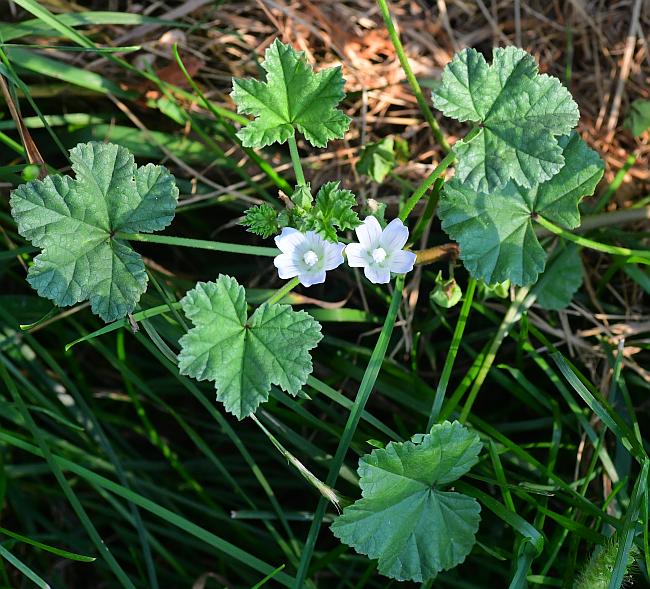Malva neglecta Wallr.
Common Mallow

Introduced
CC = *
CW = 5
MOC = 41
© SRTurner
Malva neglecta Wallr.Common Mallow | |
 |
Introduced CC = * CW = 5 MOC = 41 |
© SRTurner |
|
Family - Malvaceae Habit - Annual or perennial forb with a woody taproot. Stems - Spreading to ascending, to 1 m, multiple from base, typically simple, sparsely pubescent with simple and stellate hairs.
Leaves - Alternate, simple, petiolate, stipulate. Stipules 3-6 mm long, narrowly triangular to ovate-triangular. Petioles to 10 cm, stellate-pubescent, reduced upward. Blades 1-5 cm long, flat or slightly crisped along the margins, circular to broadly kidney-shaped in outline, unlobed or broadly and very shallowly 5-lobed (much less than 1/2 way to the base), the margins finely scalloped or toothed, the surfaces glabrous or sparsely pubescent with mostly stellate hairs, especially at the base.
Inflorescences - Flowers in axillary clusters, long-stalked, the bractlets subtending the calyx linear to narrowly oblong-lanceolate, stellate-hairy on the undersurface and with mostly simple or fasciculate hairs along the margins.
Flowers - Calyces 5-lobed, 4-7 mm long at flowering, expanding to 8 mm long at fruiting, cup-shaped, usually ascending at fruiting, at least the lobes remaining green, herbaceous, and without a distinct network of veins, the outer surface pubescent with mostly stellate hairs, the marginal hairs all less than 0.5 mm long. Petals 5, 0.6-1.2 cm long, about twice as long as the calyx at flowering, white, light pink, or pale lavender. Stamens numerous, the staminal column circular in cross-section, glabrous or hairy toward the base, the anthers usually white. Pistils with 13 locules, the carpels arranged in a flattened ring around a relatively broad central axis. Styles fused most of their length, each branch with a single linear stigmatic area along the inner side toward the tip.
Fruits - Schizocarps 1.5-2.0 mm long, the dorsal surface rounded, slightly roughened or with a faint reticulate pattern of thickenings, not transversely wrinkled, usually minutely stellate-hairy, the junction between the dorsal and lateral surfaces rounded or bluntly angled, the sides thin and papery, without visible veins. Seeds 1.0-1.5 mm long.
Flowering - April - October. Habitat - Streambanks, pond margins, roadsides, railroads, fields, pastures, lawns, farmyards, open disturbed areas. Origin - Native to Eurasia and north Africa. Lookalikes - Other species of Malva, all of which are less common in Missouri. Other info. - This species is found in a number of counties scattered across Missouri, and also occurs throughout most of the continental U.S. except for the deep south. It is recognized by its low habit, roundish, toothed leaf blades on long petioles, and flat fruit rings. The flowers are mildly showy and range in color from white to pink, usually with faint darker veins. The plant can form matted colonies under favorable conditions. It can be quite weedy in disturbed habitats including lawns, but usually does not invade intact natural communities. All aboveground parts of the plant are reportedly edible. It is related to okra, and similar in that parts of the plant produce a mucilaginous substance which can serve to thicken soups and stews. Imaginative individuals apparently thought that the fruit rings resembled tiny cheese wheels, leading to another colloquial name, "cheeses." Photographs taken at the Kansas City Zoo, 5-17-00 (DETenaglia); also in Fremont, Newaygo County, MI, 8-27-2020 and 7-4-2021 (SRTurner). |